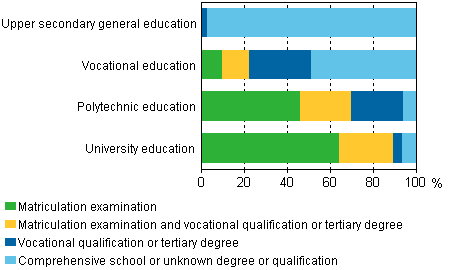Published: 29 April 2014
Close on one-half of new students in vocational education directly from comprehensive school
Of the applicants to upper secondary vocational education, 51 per cent were comprehensive school students, while their proportion of new students was 49 per cent in 2012. Of the new students in vocational education, 41 per cent had a previously attained vocational qualification or tertiary degree and ten per cent had completed only the matriculation examination. Good 97 per cent of the applicants and entrants to upper secondary general education had completed only comprehensive school. These data derive from Statistics Finland’s education statistics.
New students by educational sector and prior degree or qualification in 2012, %

In polytechnic education, 46 per cent of the new students had previously completed only the matriculation examination. Good 23 per cent had completed the matriculation examination and attained a vocational qualification or tertiary degree (13 per cent matriculation examination and vocational qualification, 10 per cent matriculation examination and tertiary degree) and 25 per cent had attained only a vocational qualification or tertiary degree (21 per cent vocational qualification, four per cent tertiary degree). In addition, six per cent had completed comprehensive school or their basic education was unknown.
In university education, 64 per cent of the new students had completed only the matriculation examination. In total, 25 per cent had previously completed the matriculation examination and attained a vocational qualification or tertiary degree (five per cent matriculation examination and vocational qualification, 20 per cent matriculation examination and tertiary degree) and just under five per cent had attained only a vocational qualification or tertiary degree (two per cent vocational qualification, three per cent tertiary degree). In addition, six per cent had completed comprehensive school or their basic education was unknown.
Altogether 356,300 young people or adults applied for education that began in 2012, and 58 per cent of them began studying. In these figures, the applicant and the new student are included once in the numbers for the educational sector. Studies were started by 94 per cent of the applicants to upper secondary general schools and 81 per cent of those to upper secondary vocational education. Thirty-six per cent of the applicants to polytechnics and 30 per cent of those to universities commenced studies. Men gained admittance to education more often than women in all other educational sectors except upper secondary general education.
If a person is included as an applicant only once, 309,100 people applied for education that began in 2012. Fifty-one per cent of these applied only to upper secondary education, 21 per cent only to polytechnic education, and 15 per cent only to university education. Eight per cent of the applicants, i.e. 24,600 people, applied to both university and polytechnic education. Simultaneously, 10,500 people, i.e. three per cent of the applicants, applied to upper secondary and polytechnic education. The number of applicants to both upper secondary education and university education amounted to 1,500, i.e. 0.5 per cent of all applicants. One per cent of all applicants, i.e. 3,900 people, applied to all educational sectors.
Source: Education. Statistics Finland
Inquiries: Riikka Rautanen 09 1734 2375, koulutustilastot@stat.fi
Director in charge: Riitta Harala
Publication in pdf-format (239.3 kB)
- Tables
-
Tables in databases
Pick the data you need into tables, view the data as graphs, or download the data for your use.
Appendix tables
- Appendix table 1. Applicants to education and new students by educational sector and gender 2012 1) (29.4.2014)
- Appendix table 2. Applicants to education by educational sector and prior education in 2012 1) (29.4.2014)
- Appendix table 3. New students by educational sector and prior education in 2012 1) (29.4.2014)
- Appendix table 4. Simultaneous application to different levels of education and new students simultaneously at different levels in 2012 1) (29.4.2014)
Updated 29.4.2014
Official Statistics of Finland (OSF):
Entrance to education [e-publication].
ISSN=1799-4527. 02 2012. Helsinki: Statistics Finland [referred: 19.12.2025].
Access method: http://stat.fi/til/khak/2012/02/khak_2012_02_2014-04-29_tie_001_en.html

